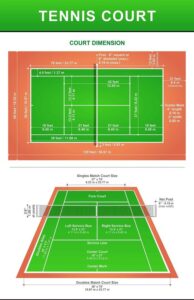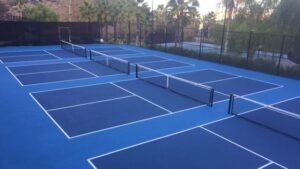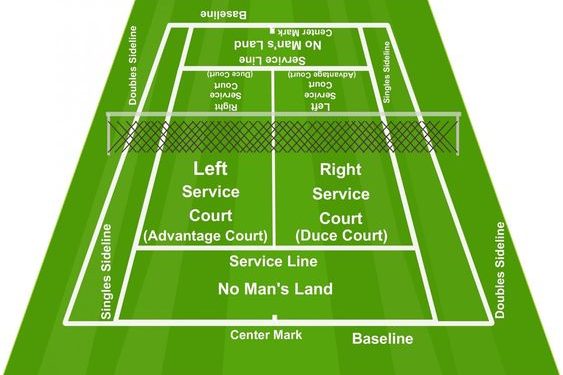What Do Tennis Court Lines Mean: All You Need to Know
Tennis court lines mark boundaries and rules for the game, such as defining in/out of play areas, service positions, and doubles boundaries. Tennis court lines serve several essential purposes in the game of tennis. They help define the boundaries of the court and establish rules and regulations for various aspects of play. Here’s a breakdown of what different tennis court lines mean:
- Singles Sidelines: These are the two lines running parallel to the net on either side of the court. They mark the boundary for singles play, meaning that the ball must land within these lines during a rally for it to be considered in play. If the ball lands outside these lines, it’s considered out, and the opposing player earns a point. Tennis court reservations
- Doubles Sidelines: These are the outermost lines on a tennis court and are used for doubles play. In doubles, the court is wider than in singles, so these lines mark the boundary for the wider court. Similar to singles, if the ball lands outside these lines, it’s considered out. Tennis court surface options
- Baselines: The baselines are the lines parallel to the net at the back of the court. They determine the depth of the court and mark the boundary for how far back a player can stand while serving or returning a serve. During rallies, the ball must also land within the baseline to be considered in play. If it lands beyond the baseline, it’s out.
- Service Lines: These lines run parallel to the net and are located between the net and the baseline. In singles play, they mark the area where the server must stand when serving. In doubles, the server’s partner also stands in this area, known as the service box, during the service.
- Center Service Line: This is the line that runs perpendicular to the net and divides the court into two equal halves. The server must aim to hit the ball over the net and into the opponent’s service box, which is bounded by this center service line and the respective singles or doubles sidelines.
- Net: The net is not a line, but it’s a critical element of the tennis court. It separates the two sides of the court and must be cleared when hitting the ball during serves, volleys, and groundstrokes. If the ball hits the net and goes over into the opponent’s side (a let), the point is replayed.
- Center Mark: This is a small mark located at the baseline in the center of the court, right behind the net. It’s used as a reference point for the server to ensure they are positioned correctly when serving. Tennis court repainting cost
Understanding these tennis court lines is essential for players to follow the rules and keep the game fair and competitive. Players must be aware of these lines to make accurate calls during matches and ensure that their shots are in or out of play. Tennis court resurfacing cost
What are Tennis Court Lines
Before we dive into the specifics, let’s establish a fundamental understanding of tennis court lines. Tennis court lines are markings on the court surface that define the boundaries, serve as guides for players, and determine the legality of shots. These lines are not just random decorations; they play a crucial role in the game. Court cleaning tips
The Singles Court
- Baselines (Singles): The two baselines at each end of the court mark the outermost boundary of the playing area for singles matches. They determine the depth of the court. Tennis court dimensions
- Sidelines (Singles): The sidelines run parallel to the net, defining the width of the singles court. Shots hit beyond these lines are considered out.
- Service Boxes (Singles): These are the rectangles inside the singles court where the server must stand while serving. The server must serve the ball into the opponent’s service box diagonally.

The Doubles Court
- Baselines (Doubles): For doubles matches, the court extends beyond the singles baselines to accommodate the wider play area. These baselines are further back from the net. Tennis court construction cost
- Sidelines (Doubles): Doubles sidelines mark the wider court’s boundary, allowing for a larger playing area.
- Service Boxes (Doubles): Similar to singles, doubles service boxes are where the server stands to serve. The server must serve diagonally into the opponent’s service box.
The Net and Center Service Line
- The Net: Although not a line on the ground, the net separates the two sides of the court. It must be cleared during play.
- Center Service Line: This line bisects the court parallel to the net and helps define the service boxes for both singles and doubles matches.

Understanding the Scoring System
Now that we’ve clarified the various lines on the tennis court, let’s briefly touch upon the scoring system. Tennis uses a unique scoring system, which can sometimes be perplexing for newcomers. Tennis set format
Scoring Lines
- The Baseline: Players start each point from behind the baseline. A serve must clear this line to be considered in play.
- The Service Line: This line marks the limit of the service boxes. A serve must land between the service line and the net to be valid.
- The Center Mark: Found at the center of the baseline, this mark divides the court into two equal halves.
- The T Service Line: In doubles matches, this line extends from the center mark and designates the point where the server must stand when serving.
Bursting the Myths: What Lines Don’t Mean
- Out-of-Bounds: Hitting the baseline or sideline doesn’t necessarily mean the ball is out. It must land outside the lines, not on them.
- Double Bounces: A ball that bounces twice before your opponent can return it is out of play. However, this has nothing to do with court lines.
- Net Cord: If the ball hits the net cord but still lands in the opponent’s court, it’s considered a valid point.
Conclusion
In conclusion, tennis court lines serve as the framework for this exhilarating sport. Understanding their significance enhances your appreciation of the game. The next time you step onto the tennis court, take a moment to acknowledge the role these lines play in making tennis the exciting and strategic sport it is.
FAQs
Q. What happens if the ball hits a sideline during a match?
A. If the ball lands on the sideline, it is considered in play, and the point continues.
Q. Do the rules regarding lines change in professional tennis?
A. No, the rules governing court lines remain consistent across all levels of tennis play.
Q. Can you challenge a line call using technology?
A. Yes, many professional matches use technology like Hawk-Eye to challenge line calls.
Q. Are there any specific rules for junior tennis regarding court lines?
A. Junior tennis follows the same court line rules as adult tennis.
Q. What should I do if I’m unsure whether a ball was in or out?
A. When in doubt, it’s always best to call the ball out and let your opponent challenge if they believe it was in.











